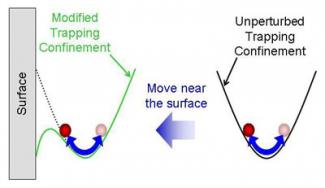Graduate students Dave Harber and John Obrecht, postdoc Jeff McGuirk, and Fellow Eric Cornell recently devised a clever way to use a Bose-Einstein condensate (BEC) inside a magnetic trap to probe the quantum behavior of free space. To do this, the researchers first created a BEC inside a magnetic trap, whose shape (where the condensate forms) resembles a cereal bowl. Then as shown in the diagram to the right, they moved the BEC in the bowl closer and closer to a glass surface until distortions in the shape of the bowl appeared. The distortions caused measurable changes in the frequency of the normal oscillations of the BEC. Harber and his colleagues measured these changes at a distance of about 5 µm from the surface, significantly farther away than in previous experiments.
To appreciate how a surface can affect the behavior of matter it isn't touching requires an understanding of quantum mechanics, according to John Obrecht. On the quantum level, an attractive force comes from the glass surface. This force originates from small changes in the quantum fluctuations of free space, where infinitesimal amounts of matter and energy routinely appear and disappear. The change in the quantum behavior of free space, called the Casimir-Polder force, is what actually distorts the shape of the cereal bowl (magnetic trap). Thus the BEC measurements were a measure of the quantum behavior of free space.
In this high-precision experiment, the researchers moved their BEC in a bowl so close to the glass surface that they could rule out the involvement of exotic forces that do not obey the laws of Newtonian gravity. The researchers reported their work in an article accepted for publication in Physical Review A.




